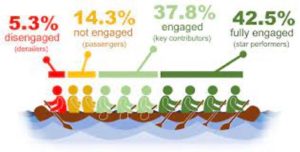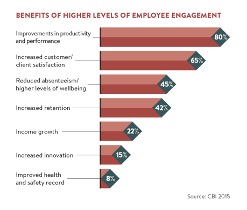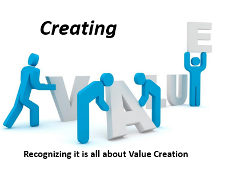
June 22, 2021
In the digital world,
fully engaged employees are a competitive imperative

Is your employee value proposition as compelling as your customer value proposition?
Most companies can tell you the approximate lifetime value of their core customers. They have long utilized the Net Promoter Score (NPS) and other customer experience/satisfaction measurement tools to track how well they are delivering their customer value proposition.
On the other hand, few companies can tell you the lifetime value of their employees and how enabling them to realize their full value has direct impact on achieving their customers’ lifetime value.
As we start to emerge from the COVID-19 workplace restrictions, everyone is caught up in the discussion about staying remote vs. going back to the office. But instead of focusing on where work gets done, shift the emphasis to creating a value proposition that will result in fully engaged employees.
As Chris Laping, author of People Before Things, said “There’s nothing more important than connecting people to purpose. It provides meaning, clarity and commits the team to the same cause.”
Employee engagement equates to customer engagement
Companies with high levels of fully engaged employees have realized a 65% increase in their customer satisfaction scores as the chart below illustrates.

Additional research studies have shown that companies with a high level of fully engaged employees:
- Have a 19.2% increase in opperating income and a 218% higher income per employee
- Deliver 147% higher earnings per share and 21% higher profitabiltity than their competitors
- Outperform the S&P 500 by 122%
So this data begs the question, what does it take to create and deliver a compelling employee value proposition that results in fully engaged employees?
It’s time to rethink your employee value proposition: from functional silo work to cross functional team work

In today’s digital enterprise, the old vertically integrated siloed organizational structures have given way to horizontally structured cross functional teams. This new structure requires increased demand for communication, coordination, and collaboration. To carry out these new roles and responsibilities, employees need new tools and new incentives:
- They need to have easy access to the latest digital technologies including cloud, mobile, and social tools wherever and whenever they need them.
- They need to have better access to real-time data analytics to help them learn faster than the competition.
- They need training and development programs that are focused on creating sustainable customer relationships, not just efficiently handling customer transactions. In fact, tools like artificial intelligence and machine learning can automate productivity tasks freeing up employees for more creative tasks.
- They need to be measured by new metrics that more accurately reflect the increasing value they bring to the organization, and the feedback needs to be fast and frequent.
- They need to be compensated for delivering both short-term results and increasing the company’s long-term power to grow.
Delivering these new tools and incentives will be critical to redefining your employee value proposition and increasing the number of your fully engaged employees. Simply put, enabling your employees to make a difference is just as important as enabling them to make a dollar.
To create a culture of sustainable employee engagement, leaders must focus on creating value

In a recent McKinsey Global Survey on “agile transformations,” those companies that were driving highly successful transformations saw a “30% increase in employee engagement by ensuring people have autonomy and purpose.” These companies were embracing business transformation “to capture enterprise value instead of incremental transformations within discrete departments. This means reimagining the entire organization as a network of high-performing teams, each going after clear end-to-end business-oriented outcomes and possessing all the skills, resources and tools to deliver enterprise value.”
Here are some leadership characteristics I have observed that distinguish successful leaders in a time of existential crisis:
- They know the right balance between dealing with current developments and getting out in front of future developments.
- They seize the narrative at the outset being very clear about what is known, what is not known, and what needs to be done to learn more.
- They recognize that a crisis ruled by unfamiliarity and uncertainty requires decisions and responses that are largely improvised.
- They promote an environment of “psychological safety” that allows people to openly discuss ideas, questions, and concerns without fear of repercussions.
- They distribute decision making authority and information sharing.
- They mobilize their organizations by setting clear priorities and empowering others to discover and implement solutions to achieving those priorities.
- They unify cross-functional teams behind mission critical outcomes and realign incentives for them to achieve those outcomes.
- They understand that “competence precedes comprehension” which puts a bias on taking action and iterative learning to make necessary adjustments in real time.
- They act with resolve and visible decisiveness.
- They know that their ultimate goal is to “make a positive difference in people’s lives.”
To successfully compete as a digital enterprise requires full commitment and engagement from your employees. Creating a compelling employee value proposition that incentivizes and rewards full employee engagement is more about what they are doing rather than where they are doing it from.
As always, I am interested in your comments, feedback and perspectives on the ideas put forth in this blog. Please e-mail them to me at here. And, if this content could be useful to someone you know please share it here:



